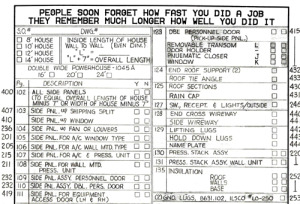
|
|
| Checklists provide organizational methods to document thorough completeness. Almost 35 years ago I found myself organizing things and making checklists to keep from overlooking important items that could be costly. So I put together a checklist at my job that allowed me to not miss things that could have a factor on keeping a job. I didn’t know at the time that this type of work would turn into the things I like to do full time, breaking down complex things into easy to follow steps for the end user. The ability to put a checklist together that works requires knowing as much about the product as possible. Leaving out an item to be considered is the same as forgetting about it and that can cost a company money if its crucial to the project.This is why its important to research each piece of the puzzle to know how that piece fits and how it affects the whole picture.
Being in the engineering field most of my life gives me a systematic approach to things, which is probably what helped develop my interest in making things orderly and easy to understand. Included as part of a checklist are page references, associated item links, sizes, location references. Helpful references are parts that may only be associated to one model and not another, so as not to spend time with unnecessary parts.
A Checklist is a reminder of what to look for, how parts are associated to each other in case you need to dig deeper for decisions. One reference may trigger an idea that was overlooked previously, or a custom request by the client, which is why areas on the checklist should be provided for those last minute notes for custom requirements to be documented.
If you need assistance with a checklist for your business, and don’t want to take time away from your busy employees, contact me and let’s discuss your business needs. |
|
